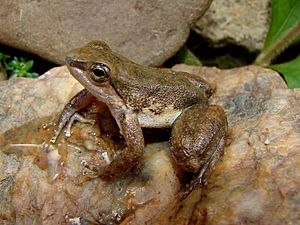Rheobates palmatus facts for kids
Quick facts for kids Rheobates palmatus |
|
|---|---|
 |
|
| Conservation status | |
| Scientific classification | |
| Synonyms | |
|
Phyllobates (Hypodictyon) palmatus Werner, 1899 |
The Rheobates palmatus, also known as the palm rocket frog, is a type of frog that lives only in Colombia. It's part of a group of frogs called the Aromobatidae family. Scientists think this frog might be part of a "species complex." This means there could be several very similar species that look almost the same but are actually different.
About the Palm Rocket Frog
The palm rocket frog has skin that helps it blend in with its surroundings. It's usually brown or gray. Its skin feels a bit bumpy at the back. One special thing about this frog is its feet: it has a lot of webbing between its toes. It's also known for being quite large compared to other frogs. Even its tadpoles (baby frogs) are big and are all one color, without any spots or patterns.
Where Palm Rocket Frogs Live
These frogs are found only in the Andes mountains in Colombia. They live on both sides of the Eastern Mountain Range and on the eastern side of the Central Mountain Range. They can be found at heights from about 350 meters (1,150 feet) up to 2,200 meters (7,200 feet) above sea level.
Since they haven't been found higher than 2,500 meters (8,200 feet), the frogs living on the two sides of the Eastern Mountain Range are separated by a very high ridge. This means they are like three different groups. Scientists have noticed that the sounds male frogs make to find a mate are different between these groups.
Palm rocket frogs live on the ground in rainforests and cloud forests. In the Rio Magdalena Valley, they can also be found in grassy fields, farm areas, and even in streams that have been affected by human activity.
Status of the Palm Rocket Frog
The palm rocket frog doesn't like being bothered by people. For example, near the road between Villavicencio and Bogotá, these frogs disappeared from their usual spots. But when a new road was built, moving traffic away from the old one, the frogs came back to where they used to breed.
The IUCN Red List of Threatened Species says this frog is of "Least Concern". This means it's not currently in danger of disappearing. It lives in a fairly large area, and its population seems to be stable. It also appears to be a frog that can adapt to different environments.


